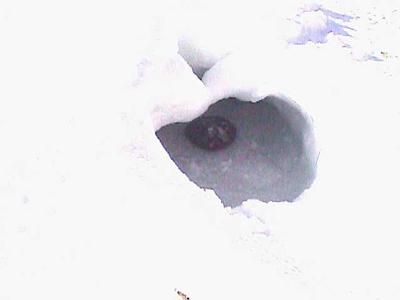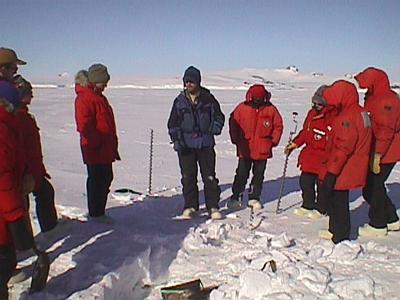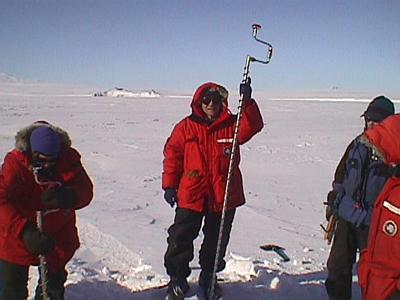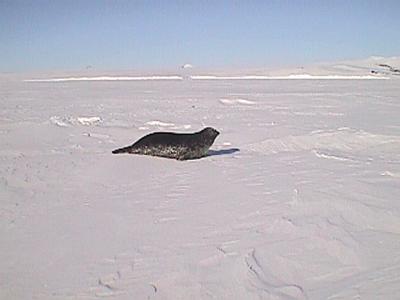31 October, 1999
10 of us were standing around the hole out on the frozen Ross Sea. It was a
beautiful, sunny day. There was no wind and the temperature was about 10F.
Suddenly she appeared. A large female Weddell seal. We could hear her
breathing, she was looking us right in the eye. This is what I came to
Antarctica for! What a thrill! Minutes later she submerged and almost
immediately her much darker, leaner mate surfaced and breathed heavily,
attempting to resaturate his blood with oxygen so he would be ready for
another deep dive to forage for fish. They repeated this sequence, taking
turns getting air for about 10 minutes. It was my first close up encounter
with a wild animal of the Antarctic and it was pretty exciting.
We were on the ice as part of a Sea Ice Training course we attended
to learn how to safely travel across the sea ice in the area around McMurdo.
This course is required of anyone who will be traveling on the sea ice
during the season. As you look out from McMurdo over the expansive frozen
Ross Sea with no open water in sight, it is hard to imagine that before the
end of the austral summer the ice on McMurdo Sound out to the open ocean
will break up and allow for ships to land at Mactown. It seems so solid and
permanent. After all, they are landing large aircraft on the sea ice within
site of town. But the ice is not permanent. It is constantly changing and
shifting due to temperature changes, wind shifts, underwater currents, and
the rising and lowering of tides. These factors cause the ice to shift and
form cracks and ridges. The ice can become quite thin in these areas and can
be dangerous for vehicle and foot travel. In the past, many vehicles and
several lives have been lost due to poor ice conditions. In fact Williams
Field, the landing strip on the permanent ice shelf, is named for Navy
Machinist Mate Warren Williams who lost his life when the bulldozer he was
operating fell through the ice. The purpose of the Sea Ice Training course
is to acquaint people with the nature of the sea ice to prevent such
tragedies in the future.
The course originated at the McMurdo Safety Training Building at 9:00AM
Saturday. We all loaded into a large wheeled vehicle called a Delta for the
ride out on the Ross Sea. Our sea ice instructor, Ted, is a member of the
Search and Rescue (SAR) team at McMurdo and has been in Antarctica for 6
seasons. Out on the ice we stopped at a red shelter dubbed "Teddy Town"
which is the base for the sea ice training. The first thing we did was learn
specialized survival techniques in case we would be trapped on the ice. The
things we learned were pretty much what we learned in "Happy Camper School"
(see journal from October 23, 1999), with adaptations for the conditions on
the hard sea ice. For example, in order to pitch a tent on the ice you need
to anchor the tent securely because of high winds. This is done either by
the use of ice screws or by drilling holes in the ice and running the tent
lines under the ice. When we were done the tents were secured firmly to the
ice.
Ted explained to us how to spot places where the ice may be thin or
cracked. There is often a hinge near shore where the "fast ice", ice that is
frozen to the shore, and the ice sheet which rises and falls with the tides
are attached. A crack often forms parallel to the shoreline making it
difficult getting on to the ice. I have seen this same situation when I have
gone ice fishing on Lake Winnebago. Cracks between two moving sheets of ice
are sometimes quite apparent. Seals are a good indicator of an ice crack.
Seals chew there way up through the ice to create their holes. They usually
chew through the thinnest ice near a crack. If you see seals lined up in an
area there is probably a crack with thinner ice near by. We saw several near
the crack we studied.
The only good way to test the ice is by drilling. We made a series
of holes across a crack to profile the thickness of the ice. We used a
special ice drill that looks like a small auger a fisherman would use to
make holes in the ice. We found the ice to vary from about 72 inches to 54
inches. For operation of heavy equipment, 30 inches of good sea ice is
considered safe. Some vehicles can operate on thinner ice with caution.
Teams of people, including Ted, go out and determine safe routes for travel
to the main locations on the ice and mark them with flags. To wander from
these "flagged" routes is dangerous without knowing the ice conditions. One
very interesting observation I made was that the shavings from the ice drill
tasted salty. Of course, you would expect this from frozen seawater, but it
was still weird.
Eventually much of the sea ice will melt. The temperature of the sea ice was
about 7F when we were out there. This is considered a good temperature for
stable ice. As the ice warms to 14F it begins to change character and at 23F
is has lost much of its strength and travel on it is stopped.
Sea ice school was very informative and the day on the sunlit Ross
Sea was wonderful. I also think this knowledge may help me to travel safely
when I return to the frozen lakes in Wisconsin.

Weddell seal surfacing in hole in Ross Sea.

Ted, our sea ice instructor, explaining how to profile an ice crack.

The large ice drill used for probing the thick sea ice.

Drilling into the sea ice.

A Weddell seal near a crack in the sea ice on the Ross Sea.
Contact the TEA in the field at
.
If you cannot connect through your browser, copy the
TEA's e-mail address in the "To:" line of
your favorite e-mail package.
|
